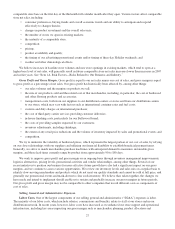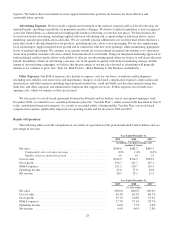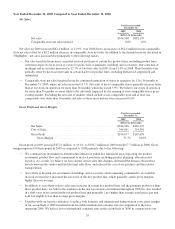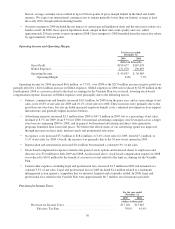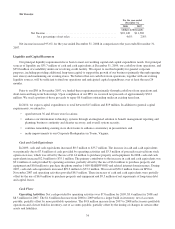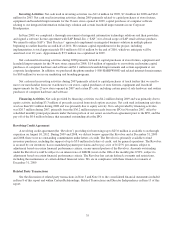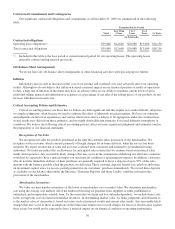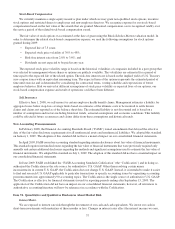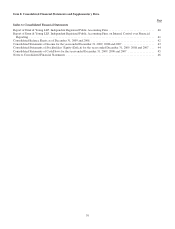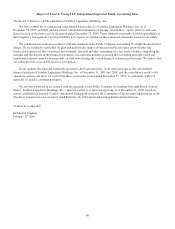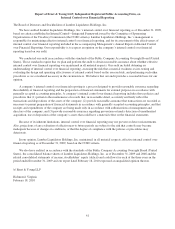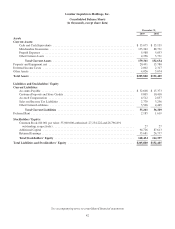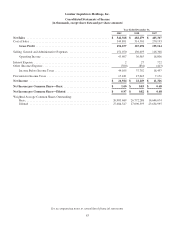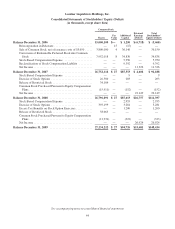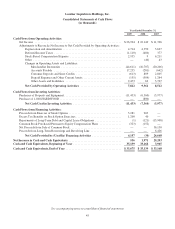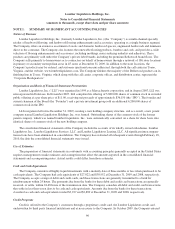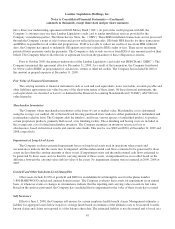Lumber Liquidators 2009 Annual Report Download - page 43
Download and view the complete annual report
Please find page 43 of the 2009 Lumber Liquidators annual report below. You can navigate through the pages in the report by either clicking on the pages listed below, or by using the keyword search tool below to find specific information within the annual report.Stock-Based Compensation
We currently maintain a single equity incentive plan under which we may grant non-qualified stock options, incentive
stock options and restricted shares to employees and non-employee directors. We recognize expense for our stock-based
compensation based on the fair value of the awards that are granted. Measured compensation cost is recognized ratably over
the service period of the related stock-based compensation award.
The fair value of stock options was estimated at the date of grant using the Black-Scholes-Merton valuation model. In
order to determine the related stock-based compensation expense, we used the following assumptions for stock options
granted during 2009:
• Expected life of 7.5 years;
• Expected stock price volatility of 39% to 45%;
• Risk-free interest rates from 2.8% to 3.6%; and
• Dividends are not expected to be paid in any year.
The expected stock price volatility range is based on the historical volatilities of companies included in a peer group that
was selected by management whose shares or options are publicly available. The volatilities are estimated for a period of
time equal to the expected life of the related option. The risk-free interest rate is based on the implied yield of U.S. Treasury
zero-coupon issues with an equivalent remaining term. The expected term of the options represents the estimated period of
time until exercise and is determined by considering the contractual terms, vesting schedule and expectations of future
employee behavior. Had we arrived at different assumptions of stock price volatility or expected lives of our options, our
stock-based compensation expense and result of operations could have been different.
Self Insurance
Effective June 1, 2008, we self-insure for certain employee health benefit claims. Management estimates a liability for
aggregate losses below stop-loss coverage limits based on estimates of the ultimate costs to be incurred to settle known
claims and claims not reported as of the balance sheet date. The estimated liability is not discounted and is based on a
number of assumptions and factors including historical trends, actuarial assumptions and economic conditions. This liability
could be affected if future occurrences and claims differ from these assumptions and historical trends.
New Accounting Pronouncements
In February 2008, the Financial Accounting Standards Board (“FASB”) issued amendments that delayed the effective
date of the fair value disclosure requirements for all nonfinancial assets and nonfinancial liabilities. We adopted this standard
on January 1, 2009. The adoption of this standard did not have a material impact on our consolidated financial statements.
In April 2009, FASB issued an accounting standard regarding interim disclosures about fair value of financial instruments.
This standard requires interim disclosures regarding the fair value of financial instruments that were previously required only
annually and certain additional disclosures regarding the methods and significant assumptions used to estimate the fair value of
financial instruments. We adopted this standard on July 1, 2009. The adoption of this standard did not have a material impact on
our consolidated financial statements.
In June 2009, FASB established the “FASB Accounting Standards Codification” (the “Codification”) and in doing so,
authorized the Codification as the sole source for authoritative U.S. GAAP. Other than resolving certain minor
inconsistencies in current U.S. GAAP, the Codification does not change U.S. GAAP. Instead, it is intended to make it easier
to find and research U.S. GAAP applicable to particular transactions or specific accounting issues by organizing accounting
pronouncements into approximately 90 accounting topics. The Codification is the single source of authoritative U.S. GAAP.
The Codification is effective for financial statements issued for reporting periods ending after September 15, 2009. The
application of the Codification did not have an impact on our consolidated financial statements, however, all references to
authoritative accounting literature will now be references in accordance with the Codification.
Item 7A. Quantitative and Qualitative Disclosures About Market Risk.
Interest Rates.
We are exposed to interest rate risk through the investment of our cash and cash equivalents. We invest our cash in
short-term investments with maturities of three months or less. Changes in interest rates affect the interest income we earn,
37


